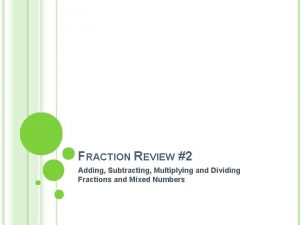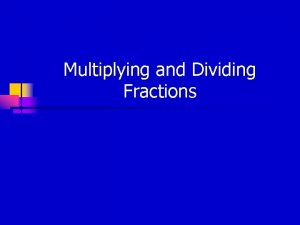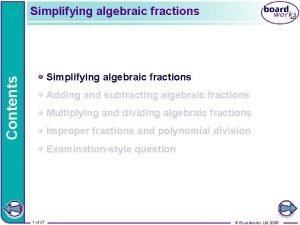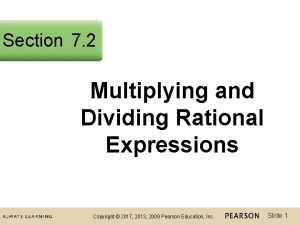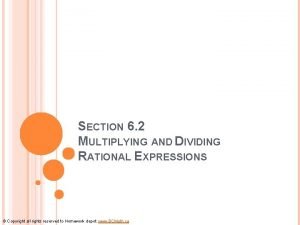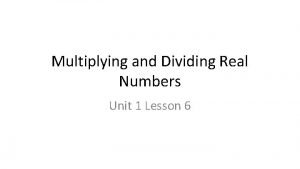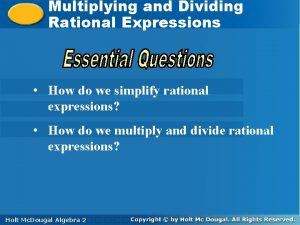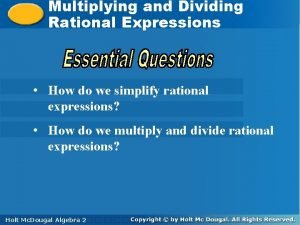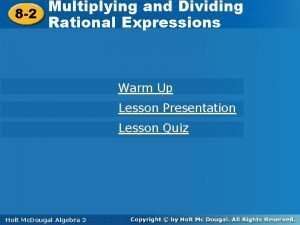Chapter 2 Multiplying and Dividing Fractions Copyright 2011











- Slides: 11

Chapter 2 Multiplying and Dividing Fractions Copyright © 2011 Pearson Education, Inc. Publishing as Prentice Hall.

2. 2 Factors and Prime Factorization Copyright © 2011 Pearson Education, Inc. Publishing as Prentice Hall.

Finding the Factors of Numbers To perform many operations, it is necessary to be able to factor a number. Since 7 · 9 = 63, both 7 and 9 are factors of 63, and 7 · 9 is called a factorization of 63. Copyright © 2011 Pearson Education, Inc. Publishing as Prentice Hall. Martin-Gay, Basic Mathematics, 4 e 3

Prime and Composite Numbers Prime Numbers A prime number is a natural number that has exactly two different factors 1 and itself. Composite Numbers A composite number is any natural number, other than 1, that is not prime. Copyright © 2011 Pearson Education, Inc. Publishing as Prentice Hall. Martin-Gay, Basic Mathematics, 4 e 4

Examples Determine whether each number is prime or composite. Explain your answers. a. 16 Composite, it has more than two factors: 1, 2, 4, 8, 16. b. 31 Prime, its only factors are 1 and 31. c. 49 Composite, it has more than two factors: 1, 7, 49. Copyright © 2011 Pearson Education, Inc. Publishing as Prentice Hall. Martin-Gay, Basic Mathematics, 4 e 5

Prime Factorization The prime factorization of a number is the factorization in which all the factors are prime numbers. Every whole number greater than 1 has exactly one prime factorization. Copyright © 2011 Pearson Education, Inc. Publishing as Prentice Hall. Martin-Gay, Basic Mathematics, 4 e 6

Examples Find the prime factorization of 63. The first prime number 2 does not divide evenly, but 3 does. Because 21 is not prime, we divide again. The quotient 7 is prime, so we are finished. The prime factorization of 63 is 3 · 7. Copyright © 2011 Pearson Education, Inc. Publishing as Prentice Hall. Martin-Gay, Basic Mathematics, 4 e 7

Divisibility Tests Copyright © 2011 Pearson Education, Inc. Publishing as Prentice Hall. Martin-Gay, Basic Mathematics, 4 e 8

Factor Trees Another way to find the prime factorization is to use a factor tree. Copyright © 2011 Pearson Education, Inc. Publishing as Prentice Hall. Martin-Gay, Basic Mathematics, 4 e 9

Examples Find the prime factorization of 30. Write 30 as the product of two numbers. Continue until all factors are prime. 30 6 • 5 3 • 2 • 5 The prime factorization of 30 is 2 · 3 · 5. Copyright © 2011 Pearson Education, Inc. Publishing as Prentice Hall. Martin-Gay, Basic Mathematics, 4 e 10

Examples Find the prime factorization of 36. Write 36 as the product of two numbers. Continue until all factors are prime. 36 9 • 4 3 • 3 2 • 2 The prime factorization of 36 is 3 · 2 · 2 or 32 · 22. Copyright © 2011 Pearson Education, Inc. Publishing as Prentice Hall. Martin-Gay, Basic Mathematics, 4 e 11
 Multiplying and dividing fractions and decimals
Multiplying and dividing fractions and decimals Adding subtracting multiplying and dividing fractions
Adding subtracting multiplying and dividing fractions Dividing fractions word problems
Dividing fractions word problems Multiplying and dividing fractions lesson
Multiplying and dividing fractions lesson Combining algebraic fractions
Combining algebraic fractions Multiplying fractions quiz
Multiplying fractions quiz 11-4 practice multiplying and dividing rational expressions
11-4 practice multiplying and dividing rational expressions 6-2 multiplying and dividing radical expressions
6-2 multiplying and dividing radical expressions Adding subtracting multiplying dividing integers
Adding subtracting multiplying dividing integers Dividing using scientific notation
Dividing using scientific notation Multiplying and dividing real numbers
Multiplying and dividing real numbers Multiplying and dividing integers notes
Multiplying and dividing integers notes

